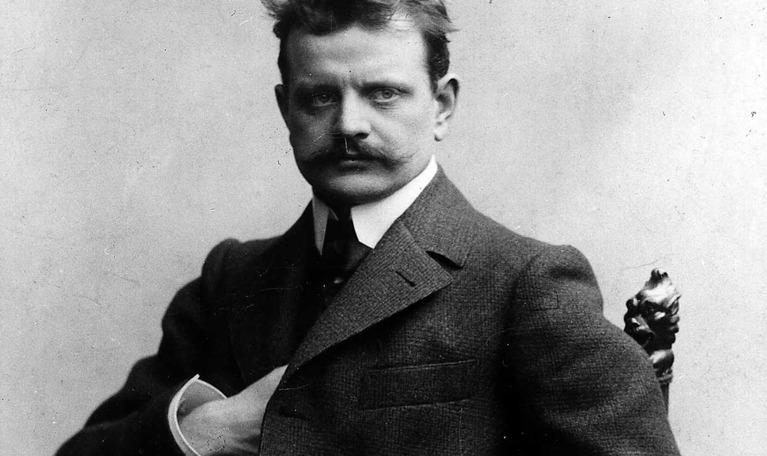Composer visits

Jean Sibelius conducted the orchestra on several occasions 1923–24.
Here, we have sifted out a few examples of the many historic composers who have appeared with the orchestra either as conductors or soloists.
Serge Rachmaninoff appeared with the orchestra on three occasions. The first time was on 12 March 1918 in Auditorium on Norra Bantorget, home to the orchestra until Konserthuset was completed in 1926. Rachmaninoff was the soloist in his own Piano Concerto No. 2, conducted by chief conductor Georg Schnéevoigt. Two days later, he was the soloist in Tchaikovsky’s Piano Concerto No. 1. He returned on 21 October that year as the soloist in his Piano Concerto No. 2, under the baton of Schnéevoigt.
Jean Sibelius conducted the orchestra on a total of seven occasions from 1923–24, in Auditorium on Norra Bantorget. In all cases, Sibelius’ own music was on the programme, and in several cases, the concerts were dedicated entirely to his music – such as his debut on 1 March 1923, which included a performance of Symphony No. 2. The most important Sibelius concert in the orchestra’s history was, however, on 24 March 1924, when Symphony No. 7 was premiered. From an international and music history perspective, this is by far the most famous premiere performance the orchestra has given.
Sergei Prokofiev performed the solo in his Piano Concerto No 2. on 4 and 8 November 1924 in Auditorium on Norra Bantorget. The first concert also included Glinka’s Overture to Ruslan and Lyudmila, and Tchaikovsky’s Pathétique Symphony. At the second, the piano concerto was framed by Mussorgsky’s Prelude and Dance of the Persian Slaves from Khovanshchina and Borodin’s Symphony No. 2 in B Minor. Issay Dobrowen was the conductor.
Paul Hindemith appeared with the orchestra on three occasions. The first time was 25 March 1931, and that time, he was the viola soloist for Vivaldi’s Concerto for Viola d’Amore in A Minor (RV 397) and for his own Chamber Music No. 5, which is a kind of viola concerto. Václav Talich conducted, and the same concert included the premiere performance of Moses Pergament’s Krelantems and Eldeling Suite. Hindemith returned on 17 and 20 February 1952 to conduct a programme dedicated entirely to his own work: Symphonic Metamorphosis of Themes by Carl Maria von Weber, Violin Concerto and Die Harmonie der Welt. Leo Berlin was the violin soloist (he subsequently became the orchestra’s concertmaster in the early 1960s, and was employed by the orchestra until 1990).
Béla Bartók appeared with the orchestra on one occasion, 18 April 1934. Chief conductor Václav Talich conducted, and Bartók was the soloist in his own Piano Concerto No. 2, which was framed by Bach’s Suite in an arrangement by Arthur Honegger, and Haydn’s Symphony No. 92 “Oxford”.
Karol Szymanowski appeared as a piano soloist with the orchestra one time, on 6 March 1935. Szymanowski played in his Symphony No. 4 – Sinfonia Concertante for Piano and Orchestra. Also on the programme were Smetana’s Overture to the Bartered Bride and Beethoven’s Symphony No. 4. Adolf Wiklund conducted.
Igor Stravinsky conducted the orchestra on one occasion. On 2 October 1935, he led a programme dedicated entirely to his own music: Divertimento “Symphonic Suite” from The Fairy’s Kiss, Suite No. 1, Suite No. 2, Violin Concerto and the Firebird Suite from 1919. Samuel Dushkin was the soloist in the violin concerto. Stravinsky conducted at Konserthuset several more times, but then with the Swedish Radio Symphony Orchestra.
Witold Lutosławski conducted the orchestra on five occasions. His debut in Konserthuset was on 6 January 1974 in a programme completely dedicated to his own music: Livre Pour Orchestre, Paroles Tissées for Tenor and Cello Concerto. The tenor soloist was Christer Solén and the cello soloist was Erling Bløndal Bengtsson. Lutosławski subsequently returned and conducted two concerts in November 1987, in conjunction with the composer festival, which was dedicated to Lutoslawski’s music that autumn. In April 1992, he conducted two concerts of his own music, the pieces Mi-Parti, Cello Concerto with Torleif Thedéen as soloist, and Symphony No. 3.
